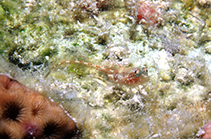| Family: |
Chaenopsidae (Pike-, tube- and flagblennies) |
| Max. size: |
3.24 cm SL (male/unsexed) |
| Environment: |
reef-associated; marine; depth range 3 - 9 m |
| Distribution: |
Western Central Atlantic: Venezuela. |
| Diagnosis: |
Dorsal spines (total): 20-21; Dorsal soft rays (total): 10-13; Anal spines: 2-2; Anal soft rays: 22-24. This species (without an orbital cirrus and with a red banner) is distinguished by the following characters: TP territorial males found in holes with a black head and blackened anterior dorsal fin with a distal red band over a narrow white band and a thin white or blue margin, the red band extending posteriorly to 7th-10th spinous membrane, and forming a straight line or curved down when fully erected in displaying TP, the first dorsal-fin spine relatively short, when adpressed reaching to 5th-6th spine base, about half HL, the subsequent spines progressively slightly longer (Ref. 125603).
Dark-shaded and pale TP with a similar red-banded dorsal fin, but a wider white band, and dark membrane only on first one or two membranes; with a row of large dark spots along body just below base of spinous dorsal fin, absence of rows of dark spots along spinous-dorsal-fin membranes or along lateral midline or mid-way between lateral midline and base of dorsal fin; a large black patch around the anus; head mostly unmarked except for a pale or bluish reticulated pattern under the lower jaw; a dark or reddish oblique band across its iris; no opercular bands or lines (Ref. 125603).
IP with short first several dorsal-fin spines, the first spine reaching to base of 4th-5th spine base when adpressed, the fourth spine shortest and midfin spines longest, forming a slightly notched dorsal-fin profile, the first few membranes with dark reticulated bands or lines and a reddish edge (even in juveniles); head and body are mostly unmarked except for dark or reddish oblique band across iris, a row of reddish or dark spots along body just below the base of spinous dorsal fin, a large black patch around anus, a wide internal reddish or dark band along sides of the vertebral column, and a dark distal band along anterior of anal fin. Colouration: live colors include orange, pink and yellow; cranial pattern a simple pale band 2 and 4; no IP head spots or markings near the pectoral-fin base; the IP fish and pale TP individuals live in groups on reef (vs. no apparent grouping behavior in any congeners) (Ref. 125603). |
| Biology: |
Occurs in shallow waters,on sand and rocks. Form relatively tight groups perched over coral
heads, often as separate groupings of IP females and pale TP fish, while territorial black males are found alone in burrows, usually challenged by passing pale TP individuals (Ref. 125603). Feeds on zooplankton. |
| IUCN Red List Status: |
Data deficient (DD); Date assessed: 18 October 2007 Ref. (130435)
|
| Threat to humans: |
harmless |
Source and more info: www.fishbase.org. For personal, classroom, and other internal use only. Not for publication.

